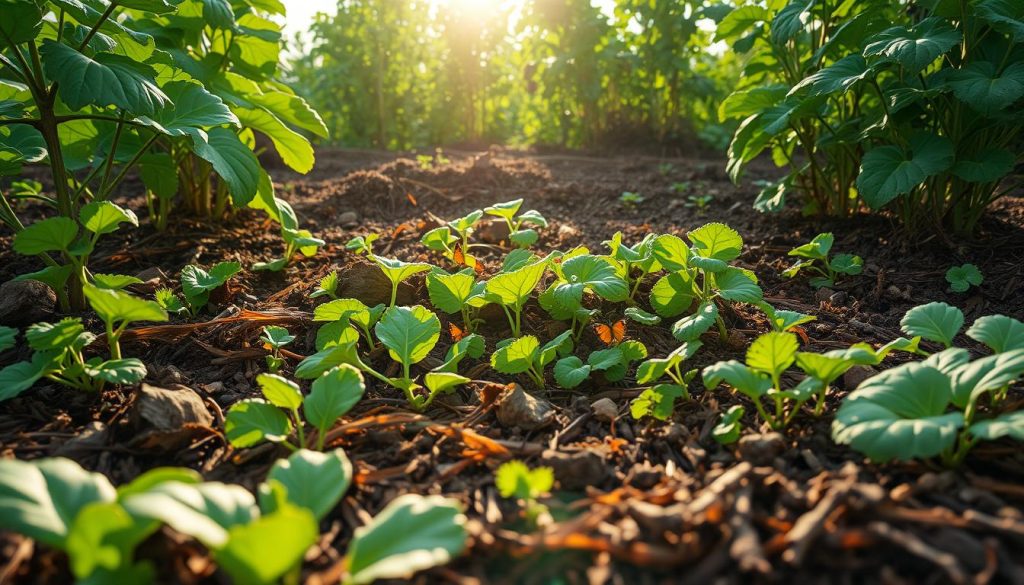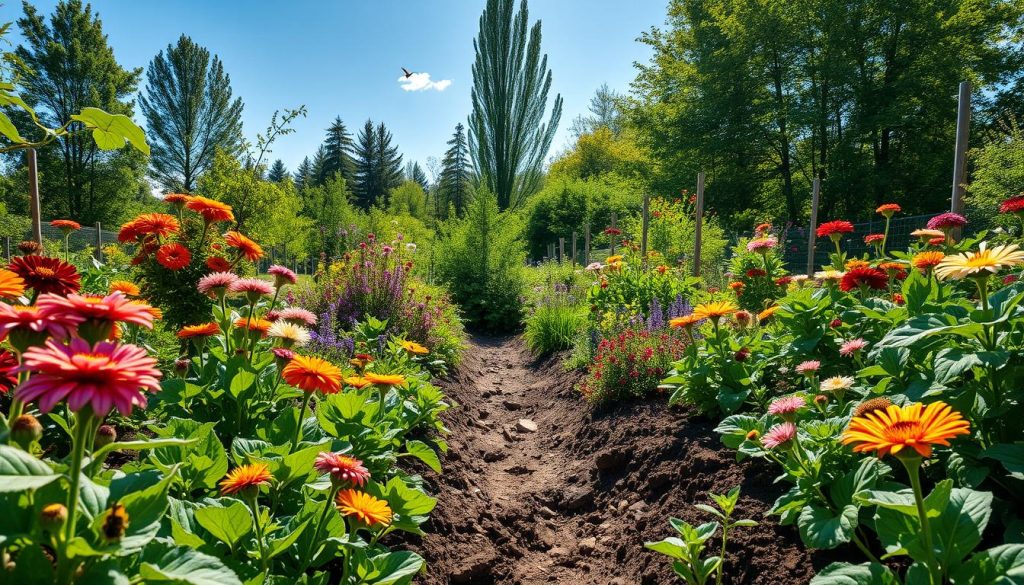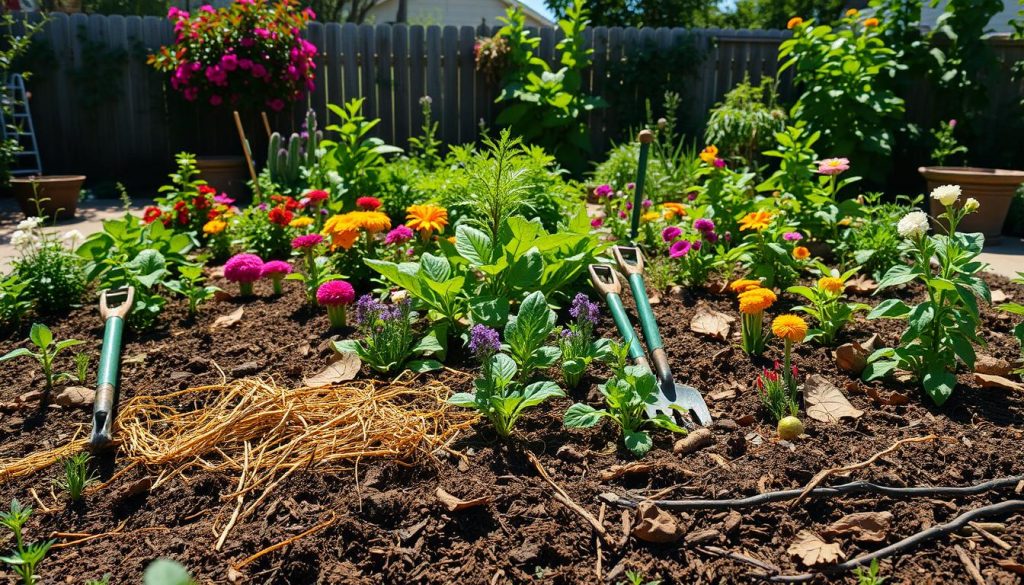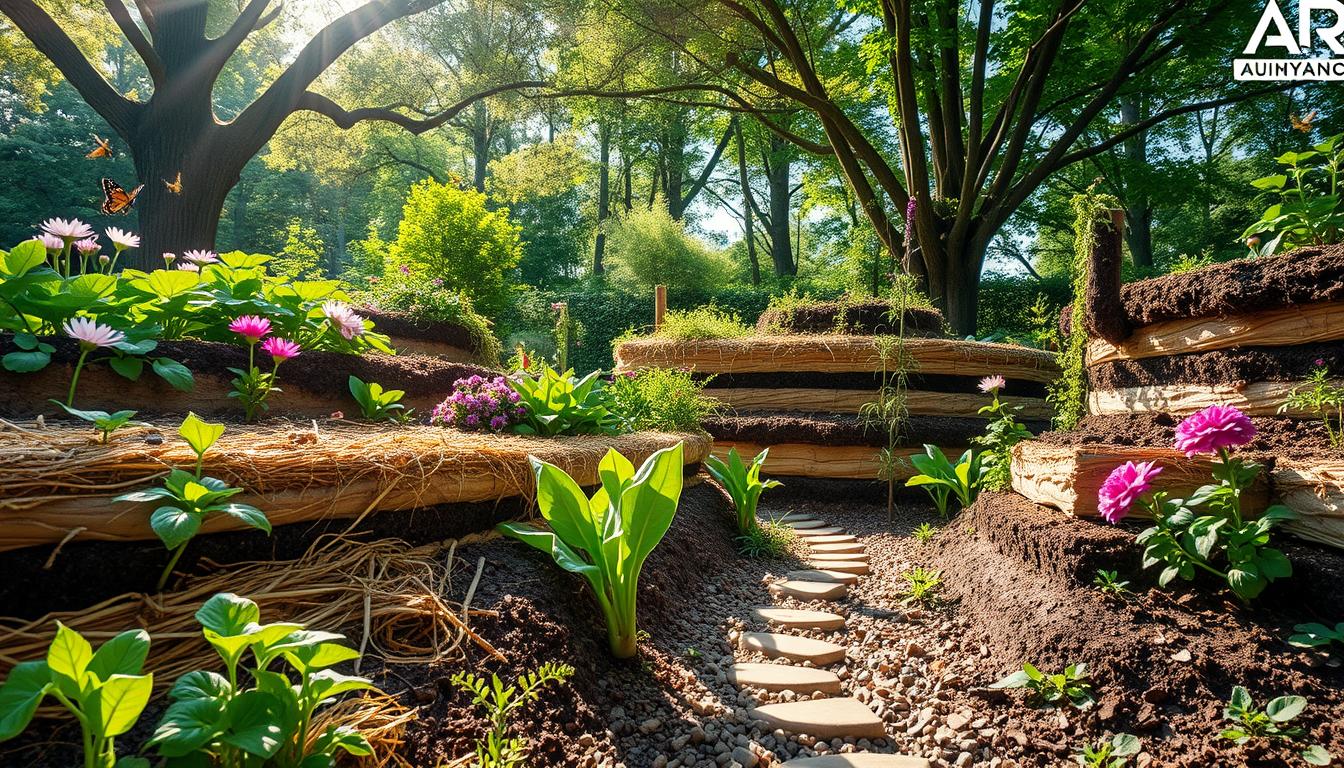I chose no-dig gardening for its eco-friendly benefits. It fits my goal of reducing environmental harm. This method makes gardening easy and eco-friendly, perfect for my busy life.
No-dig gardening is ideal for an eco-friendly garden. It avoids tilling, which can harm soil and ecosystems. This approach is good for the planet and helps grow healthy plants.
In this article, I’ll share my no-dig gardening journey. I’ll talk about its benefits and challenges. I aim to inspire you to try sustainable gardening in your yard.
Understanding No-Dig Gardening Principles
No-dig gardening fits with organic, natural, and permaculture gardening. It keeps the soil intact, stops erosion, and boosts biodiversity. By not digging, we let the soil’s ecosystem flourish naturally.
This method is good for the planet because it cuts down on harmful chemicals. It uses organic stuff like compost and mulch to help plants grow. Some main perks of no-dig gardening are:
- Soil gets better and more fertile
- More life and services in the ecosystem
- Less erosion and pollution in water
- Less harm to the environment and climate
Exploring no-dig gardening excites me for a greener yard. I aim to help the planet and encourage others to join me. 
What is No-Dig Gardening?
No-dig gardening lets you grow plants without messing with the soil. You just add compost or mulch on top. This keeps moisture in, weeds out, and soil temperature right.
Key Benefits for Sustainability
No-dig gardening is great for the earth. It stops erosion, makes soil better, and adds more life. Not digging keeps the soil’s ecosystem strong and helps plants grow well.
How It Works
No-dig gardening makes a system that needs little care and outside help. Organic stuff, compost, and mulch make the soil rich and diverse. This supports plants and helps the ecosystem.
My Inspiration to Start No-Dig Gardening
I’ve always wanted a green outdoor space. Learning about sustainable landscaping sparked my interest in no-till and regenerative gardening. This journey has taught me about protecting our planet and making a difference locally.
Many experts inspired me to try no-dig gardening. They stressed the importance of learning, trying new things, and adapting. No-dig gardening is more than a method; it’s a way of thinking that needs patience and a keen eye for your garden’s needs.
Learning from Sustainable Gardening Experts
I’ve learned a lot from seasoned gardeners who use sustainable and no-till methods. Their stories show the power of sticking with it and being creative. Key lessons I’ve picked up include:
- Soil conservation and health are crucial
- Using natural and organic materials is beneficial
- Reducing waste and environmental impact is important

Personal Experiences with Traditional Gardening
My experiences with traditional gardening have shaped my no-dig approach. I’ve learned from both my failures and successes. Now, I focus on sustainable practices that help our environment and promote regenerative gardening.
Tips for Starting My No-Dig Garden
To start my no-dig garden, I had to think about a few key things. No-dig gardening is about making a garden that needs little care and is good for the planet. It’s important to pick the right spot for your garden. This spot will help your garden grow well and be healthy.
When starting, choose the right materials like compost and mulch. Pick plants that are good for the environment. Start small and grow your garden bit by bit. This way, you waste less and use less water and chemicals.

- Choose a location that gets enough sunlight and drains well
- Select plants that fit your climate and soil
- Use compost and mulch to make the soil rich
By following these tips, you can make a no-dig garden that’s good for the planet. It will help make the future more sustainable.
Maintaining My No-Dig Garden
To keep my no-dig garden thriving, I use organic gardening methods. These methods help keep the soil healthy and support biodiversity. This way, plants and microorganisms work together, keeping the garden balanced.
By using natural gardening techniques, I reduce my environmental impact. I also ensure a sustainable food supply for myself and others.
Some key practices I follow for maintaining my no-dig garden include:
- Watering deeply but infrequently to encourage deep root growth
- Using compost and natural fertilizers to enrich the soil
- Implementing permaculture gardening principles to create a self-sustaining ecosystem
I observe and respond to my garden’s unique conditions. This helps me address any issues and make necessary adjustments. Sometimes, I introduce beneficial insects to control pests or add organic matter to improve soil structure.
Through these efforts, I maintain a healthy and productive no-dig garden. It not only provides fresh produce but also supports local biodiversity.
Community and No-Dig Gardening
No-dig gardening is more than just a hobby; it’s about building a community. I’ve learned so much by connecting with local gardeners. We swap tips, recommend tools, and share our experiences.
Being part of a community has many benefits. We can share resources and knowledge, which helps us garden more efficiently. For instance, we share seeds and tools, saving money and boosting productivity. This teamwork also builds a sense of support and learning together.
Benefits of Community Involvement
- Shared knowledge and expertise
- Access to local resources and materials
- Opportunities for collective learning and mutual support
- Increased sense of community and belonging
Workshops and events are great for joining the no-dig gardening community. These gatherings let us share our stories, learn from experts, and meet others who care about sustainable gardening. I’ve discovered new techniques, tools, and made friends who share my passion.
Reflecting on My No-Dig Gardening Journey
Looking back, I feel proud and accomplished about my no-dig gardening journey. Overcoming challenges like building the perfect raised beds and learning soil management has deepened my commitment to sustainable gardening.
Challenges Faced and Lessons Learned
Adapting to the unique watering and fertilizing needs of a no-dig garden was tough. But, I found the right balance of moisture and organic matter for my plants. This journey taught me the value of patience and being adaptable in no-dig gardening.
My Garden’s Impact on Local Ecosystem
My backyard’s transformation into a lush no-dig oasis has greatly impacted the local ecosystem. I’ve seen more pollinators like bees and butterflies. The native plants I’ve added have also helped birds and other wildlife, boosting neighborhood biodiversity.
Future Goals for My Sustainable Garden
My no-dig garden’s future goals are exciting. I want to try new techniques, like companion planting to fight pests and increase yields. I also aim to encourage my neighbors to garden more sustainably, sharing my knowledge to foster a greener community.

